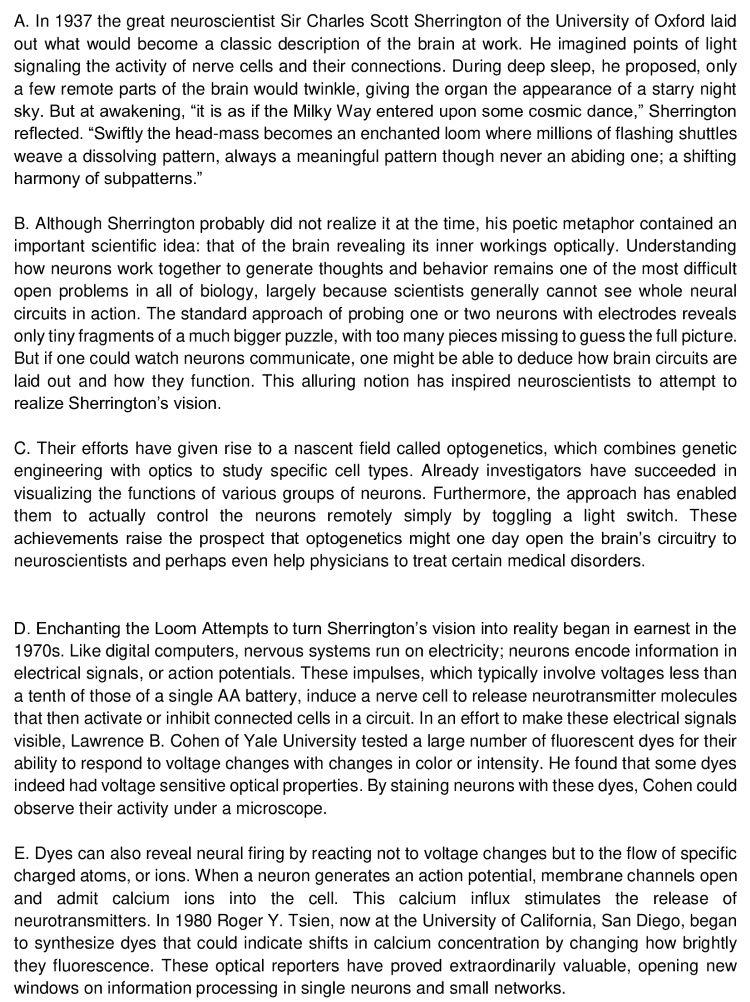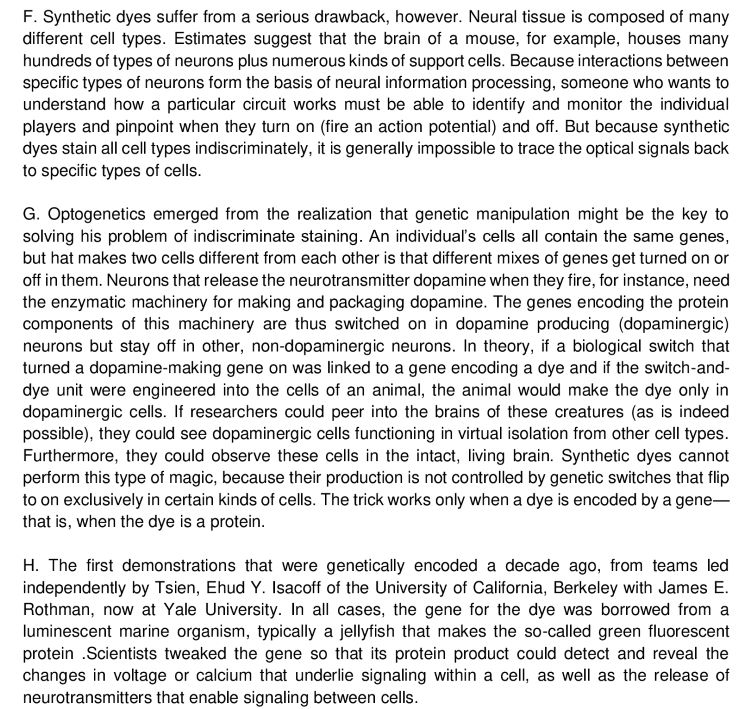Brain Activating – IELTS Reading Answers
8 min read
Updated On
-
Copy link
Table of Contents

Limited-Time Offer : Access a FREE 10-Day IELTS Study Plan!
The IELTS Academic Reading Module of the IELTS can be the top-scoring category, with diligent practice. To achieve the best results in this section, you must understand how to approach and answer the different Question types in the Reading Module. By solving and reviewing Sample Reading Questions from past IELTS papers, you can ensure that your Reading skills are up to the mark.
Reading Passage
You should spend about 20 minutes on Questions 1-13, which are based on the Reading Passage below.
Brain Activating

 QUESTIONS
QUESTIONS
Questions 1-5
Do the following statements agree with the information given in Reading Passage 1? In boxes 1-5 on your answer sheet, write
TRUE if the statement agrees with the information
FALSE if the statement contradicts the information
NOT GIVEN if there is no information on this
1 Sherrington’s imaginary picture triggered scientists’ enthusiasm of discovering how the whole set of neurons operates.
2 A jumped-up domain optogenetic is a pure unexpected accident.
3 Electric tension is one key component to realize the communication between neurons.
4 The variations of voltages is the sole response that the coloration of related neurons could provide when neural discharge takes place.
5 The vital defect synthetic dyes possess is the most challenging obstacle for researchers to overcome .
Questions 6-10
6 a sea creature producing light triggered by certain genes
7 first attempts to make a great idea come true
8 the reason to explain the failure of synthetic dyes
9 difficulty in observing how the whole set of neurons works
10 visual indicators to show how information is handled in and between cells in the Brain
Book a FREE Demo with our experts to learn tricks and techniques to ace the IELTS Reading!
Questions 11-13
Summary
Synthesized by enzymatic machinery , 11 ……………….. plays as a vehicle for the information flow between cells. Protein is the ingredient of the enzymatic machinery, so first it needs genes in charge of encoding the required protein 12 ……………….. before the neurotransmitter is produced. This 13 ……………….. can be used to differentiate the dopaminergic neurons from the non dopaminergic counterparts with a premise that the dye is a protein after a transfer process.
Brain Activating IELTS Reading Answers With Locations and Explanations
Check out the answer key for this IELTS Academic Reading passage, Brain Activating, with location and explanations.
1 Answer: True
Question type: True/False/Not Given
Answer location: Paragraph B
Answer explanation: The initial lines of paragraph D illustrates that Although Sherrington probably did not realize it at the time, his poetic metaphor contained an important scientific idea: that of the brain revealing its inner workings optically. Understanding how neurons work together to generate thoughts and behavior remains one of the most difficult open problems in all of biology, largely because scientists generally cannot see whole neural circuits in action. These lines suggest that Sherrington didn’t realize that his imaginary picture triggered scientists’ enthusiasm for exploring and understanding how neurons work together to generate thoughts. Thus, the statement agrees with the information, so, the answer is True.
2 Answer: Not Given
Question type: True/False/Not Given
Answer location: Paragraph C
Answer explanation: The initial lines of paragraph C reveals how the scientist’s efforts led to the rise of a nascent field called optogenetics. etics, which combines genetic engineering with optics to study specific cell types. We can deduce from these lines how optogenetics was introduced, combining genetic engineering with optics to study some specific type of cells. As a result, there’s no reference to the fact that a jumped-up domain optogenetic is a pure unexpected accident. So, the answer is Not Given.
3 Answer: True
Question type: True/False/Not Given
Answer location: Paragraph D, line 2
Answer explanation: The 2nd line of paragraph D illustrates that the nervous system runs on electricity just like the digital computers. Neurons encode information in electrical signals or action potentials. These lines indicate that nervous systems operate via electricity. The neurons encode information in electrical signals or action potentials. As a result, electric tension is one of the primary components to realize an effective communication between the neurons. Thus, the statement agrees with the fact, so the answer is True.
4 Answer: False
Question type: True/False/ Not Given
Answer location: Paragraph E
Answer explanation: The initial lines of paragraph E states that dyes can also reveal neural firing by reacting not to voltage changes but to the flow of specific charged atoms, or ions. These lines indicate that dyes can also reveal neural firing, which happens only to the flow of specific charged atoms or ions, and not to the reaction of voltage changes. Thus, the statement contradicts the information, so, the answer is False.
5 Answer: Not Given
Question type: True/False/Not Given
Answer location: Paragraph F
Answer explanation: We can find reference for Synthetic dyes in Paragraph F, which reveals that synthetic dyes suffer from a serious drawback, however. Neural tissue is composed of many different cell types. These lines suggest that synthetic dyes are suffering from a critical drawback, and that the neural tissues are composed of different types of cells. As a result, there’s no reference that the vital defect synthetic dyes possess is the most challenging obstacle for researchers to overcome. Thus, the answer is Not Given.
6 Answer: H
Question type: Matching Information
Answer location: Paragraph H, line 3
Answer explanation: A reference for sea creature (Jellyfish) can be found in the 3rd line of paragraph H, where it is mentioned that In all cases, the gene for the dye was borrowed from a luminescent marine organism, typically a jellyfish that makes the so-called green fluorescent protein. These lines indicate that jellyfish was the sea creature, a luminescent marine organism that produced light when the gene for the dye was borrowed. Thus, the information for the statement can be found in paragraph H, so, the answer is Paragraph H.
7 Answer: D
Question type: Matching Information
Answer location: Paragraph D
Answer explanation: The initial line of paragraph D reveals that enchanting the Loom Attempts to turn Sherrington’s vision into reality began in earnest in the 1970s. These lines suggest that the attempts to turn Sherrington’s vision into reality began in the 1970s. Thus, paragraph D states the first attempts to make a great idea come true, so, the answer is Paragraph D.
8 Answer: F
Question type: Matching Information
Answer location: Paragraph F, last line
Answer explanation: The last line of paragraph F illustrates that as the synthetic dyes stain all cell types indiscriminately, it is generally impossible to trace the optical signals back to specific types of cells. These lines indicate that it is important to track the optical signals back to specific cell types because synthetic dyes stain all cell types indiscriminately. Thus, it is the reason to explain the failure of synthetic dyes. So, the answer is Paragraph F.
9 Answer: B
Question type: Matching Information
Answer location: Paragraph B, line 3
Answer explanation: Line 3 of paragraph B states that understanding how neurons work together to generate thoughts and behavior remains one of the most difficult open problems in all of biology, largely because scientists generally cannot see whole neural circuits in action. These lines indicate that observing how the entire set or neurons work together to generate thoughts and behavior remains one of the most difficult open problems due to the fact that the scientists cannot see entire neural circuits in action. Thus, the answer is Paragraph B.
10 Answer: E
Question type: Matching Information
Answer location: Paragraph E, last line
Answer explanation: The last line of paragraph E illustrates that these optical reporters have proved extraordinarily valuable, opening new windows on information processing in single neurons and small networks. We can understand from these lines that by opening new windows on processing in single neurons and small networks, the optical reporters have proved extraordinarily valuable, that is the visual indicators to show how information is handled in and between the cells in the brain. Thus, the answer is Paragraph E.
11 Answer: Dopamine
Question type: Summary Completion
Answer location: Paragraph G, line 4
Answer explanation: The 4th line of paragraph G states that Neurons that release the neurotransmitter dopamine when they fire, for instance, need the enzymatic machinery for making and packaging dopamine. These lines indicate that neurons releasing neurotransmitter dopamine while firing require enzymatic machinery for making and packaging dopamines. Thus, synthesized by enzymatic machinery, dopamine plays a vehicle for the information flow between cells. So, the answer is Dopamine.
12 Answer: Switched on
Question type: Summary Completion
Answer location: Paragraph D, line 6
Answer explanation: The 6th line of paragraph D depicts that the genes encoding the protein components of this machinery are thus switched on in dopamine producing (dopaminergic) neurons but stay off in other, non-dopaminergic neurons. We can deduce from these lines that the genes encoding the protein component of the enzymatic machinery are switched in dopaminergic neurons. Therefore, the protein is the ingredient of the enzymatic machinery, and so it requires genes to encode the protein switched on before the neurotransmitter is produced. Thus, the answer is Switched on.
13 Answer: Switch-and dye unit
Question type: Summary Completion
Answer location: Paragraph D, line 8
Answer explanation: The 8th line of paragraph D states that in theory, if a biological switch that turned a dopamine-making gene on was linked to a gene encoding a dye and if the switch-and-dye unit were engineered into the cells of an animal, the animal would make the dye only in dopaminergic cells. These lines suggest that the Switch-and-dye unit can be used to differentiate the dopaminergic neurons from the non-dopaminergic counterparts with a premise that the dye is a protein after a transfer process. Thus, the answer is the Switch-and-dye unit.
Check More IELTS Reading Answers
Practice IELTS Reading based on question types

Start Preparing for IELTS: Get Your 10-Day Study Plan Today!
Recent Articles

Nehasri Ravishenbagam

Haniya Yashfeen

Haniya Yashfeen

Haniya Yashfeen




Post your Comments